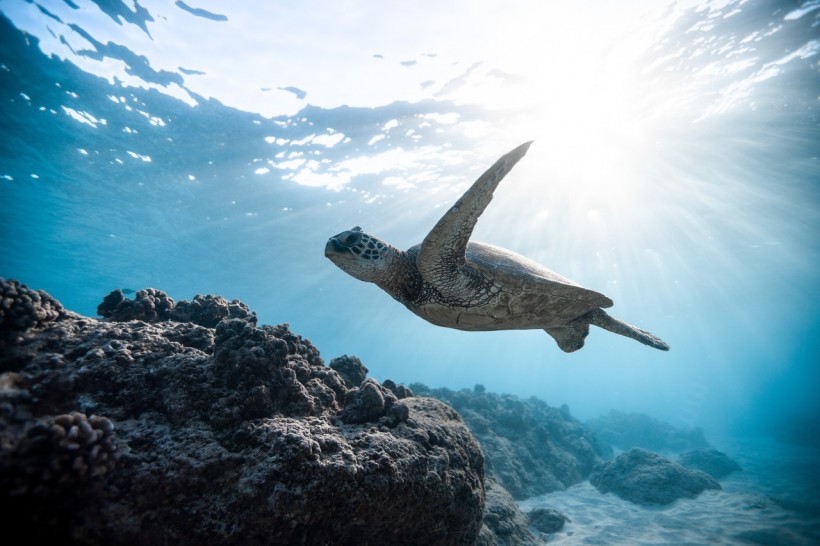
(Photo : Stranded Loggerhead Turtle Now Swimming Safely at SeaWorld)
A team of volunteers from Oregon Coast Aquarium recently saved a loggerhead turtle stranded in Lincoln City on the Oregon Coast. A private citizen spotted the animal, calling in the rescuers for help. Today, thanks to several volunteers' combined efforts and a flight to San Diego, California, that loggerhead turtle is safely relocated to SeaWorld as a part of their robust sea turtle conservation effort.
A Rescue Story for the Books
The turtle was first spotted on Nelscott Beach in early February. It took some time, but the Oregon Coast Aquarium managed to retrieve the turtle, who was likely caught up in cold water, causing it to lose its ability to move or eat in a state of torpor, caused by being cold-stunned. This turtle washed ashore, and thus, was able to be rescued.
The Oregon Coast Aquarium's Curator of Fish and Invertebrates, Evonne Mochon-Collura, took the next step by reaching out to another organization to handle the access and triage of the turtle. The Marine Mammal Stranding Network's Jim Rice managed to reach the turtle to transport it.
Once rescuers reached the turtle, its temperature was determined to be just 50 degrees, far below the safe level of 75 degrees. Rescuers determined the turtle was a sub-adult female, and treatment would not be simple.
Using water baths and fleece-lined blankets, the volunteers worked to slowly raise the turtle's temperature to a safe level, without shocking the turtle via swift temperature changes. The goal was to raise the turtle's temperature by about 5 degrees per day. The animal was carefully washed and monitored to ensure its health was improving regularly.
Recovery and Making a Move
Over time, blood samples and X-rays found the loggerhead turtle was improving and becoming more stable. Its mobility and appetite grew. Most often, the Oregon Coast Aquarium provides just short-term care to stranded turtles like this before releasing them back into their natural habitat.
Instead, after regaining enough health to safely make the passage, the turtle was flown to SeaWorld San Diego. The Turtles Fly Too nonprofit organization made the trip possible. Before taking flight, the aquarium lubricated the turtle to help minimize the risk of dehydration. They also built and strapped it to a custom stretcher and placed it in a crate uniquely designed to maintain safe body temperature.
Turtles Fly Too is an organization dedicated to helping turtles just like this one. The organization works to coordinate and facilitate the use of planes to help transport turtles and other endangered species where they need to go to receive necessary care. They provide the critical response teams needed to make such a move possible. They also work to educate the community on the conservation of habitats for marine animals.
The transport (and triage) was successful, and the turtle was swimming in one of SeaWorld's outdoor pools shortly thereafter.
Time at SeaWorld San Diego
SeaWorld received the animal and ensured it remained healthy. SeaWorld's expert staff continued to monitor the animal's condition and worked to support its healing and overall recovery. The eventual goal is to release the animal back into a safe habitat.
As an endangered animal, the move back to the natural habitat is critical. Even reintroducing one animal back into the natural habitat can prove to be enough to impact the overall population of the species. That continues to be the focus of the organization.
SeaWorld's Goals to Support Endangered Turtles
SeaWorld parks, including the San Diego location, work with dozens of loggerhead, green, hawksbill, leatherback, and Kemp's ridley turtles. Each of these is a type of endangered or threatened animal. They also work with land turtles and tortoises. Since 2017, SeaWorld has helped to rescue 2,210 turtles.
These efforts are necessary for many reasons. These large, slow-moving creatures often get caught up in fishing gear. Sometimes, they strike a motorboat. Other times, it is the cold weather that makes it impossible for the turtles to continue along migration paths.
A cold weather snap, which can happen in many regions where these turtles live, can be deadly. When water temperatures are lower than normal, the turtle's metabolism slows down significantly. The turtles become hypothermic and eventually stop eating, in a condition called cold-stunning. Most often, they are found simply floating along the water's surface in a semi-dormant state, unable to move or swim.
One example of SeaWorld's efforts to help these cold-stunned turtles occurred in January of 2010. At that time, over 300 of these turtles were found drifting along the water. They were taken to SeaWorld Orlando's Sea Turtle Rehabilitation Center. The animals were slowly warmed using heat lamps and blankets, allowing them to recover. Of the 300 rescued turtles, SeaWorld was able to safely release over 250 of them back to the sea after a successful recovery. This was the organization's largest effort for cold-stunned turtles in its history.
As a leading rescue, research, and rehabilitation entity, SeaWorld does more than just help turtles battling unseasonably cold waters. They help these turtles through a wide range of risks they encounter, often thanks to human mistakes and damage to habitats. A big concern is oil spills, which are a common impact not only on the animals themselves, but also on their food supplies. Their nesting and basking areas, all critical to the turtles' abilities to thrive and continue to grow their population, are at risk during oil spills.
In 2010, SeaWorld Orlando provided safe spaces to allow almost 130 turtles, all impacted by oil spills, to recover. The animals were pulled out of the waters and given exams, warm places to recuperate, and all care needed. Nearly all of the turtles recovered were then placed into a safer area with less risk of oil spills.
Additionally, SeaWorld has worked with numerous turtles in the treatment for abnormal tumorous growths. These growths, called fibropapillomatosis, often look like scales and can develop on the eyes, mouth, and back of the neck. These are dangerous and can impact the animal's ability to feed and swim normally. The organization works to treat these to minimize health risks.
Turtles like the loggerhead are endangered. They require help and support to encourage the growth and continuation of the species. For its part, SeaWorld and other volunteer and nonprofit organizations continue to provide opportunities to help these animals as climate change and human damage limit their ability to thrive in the wild.
* This is a contributed article and this content does not necessarily represent the views of hngn.com








